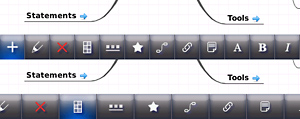 An updated version of MindBerry – a mind mapping application for the BlackBerry platform – was recently released that fully supports the BlackBerry Storm smartphone. It takes full advantage of the Storm’s large touch screen.
An updated version of MindBerry – a mind mapping application for the BlackBerry platform – was recently released that fully supports the BlackBerry Storm smartphone. It takes full advantage of the Storm’s large touch screen.
One of its most innovative features is a toolbar that has some unique capabilities: In landscape mode, the 12-button toolbar straddles the bottom of the screen nicely. Triple tapping it makes the toolbar buttons larger, so they are easier to tap. If you turn the Storm to a portrait orientation, there isn’t as much room to display the toolbar, so it slides from side to side to give you access to all 12 buttons – a very elegant solution!
Other touch capabilities supported by this Storm-compliant mind mapping app include:
- To scroll the mindmap, you touch the map and move your finger to the desired position on the screen.
- To add a child node, you double tap on the parent node.
- To fold or unfold a node, you simply click on it.
- To move a node from one location within your map to another, you touch and hold your finger on a node for one-half second, until a movement symbol appears at the top-right corner of the screen. Then, move your finger to drag the node. Release your finger to drop it in its new location.
Other new and improved features in this new version of MindBerry (v1.0.91) include:
- The ability to create hyperlinks to web pages, local files and other mind maps.
- A recent file list has been added, enabling you to open recently edited maps faster than before.
- You can now designate the folder on the BlackBerry in which you want MindBerry to store all of your maps.
- The toolbar now includes an auto-organize function
- The developers have improved MindBerry’s speed versus earlier versions.
As smartphones become more and more popular, it’s exciting to see that the developers of MindBerry have updated it for the BlackBerry Storm product line.
Now that MindBerry is compatible with the BlackBerry Storm, it also begins to more aggressively close the gap between itself and the mind mapping apps developed for the Apple iPhone and iPod Touch. One advantage that this platform has is the ability to e-mail maps to other people. In contrast, users of the Apple handhelds must suffer with more complicated workarounds, because Apple only allows image files to be e-mail attachments at this time.

Leave a Reply